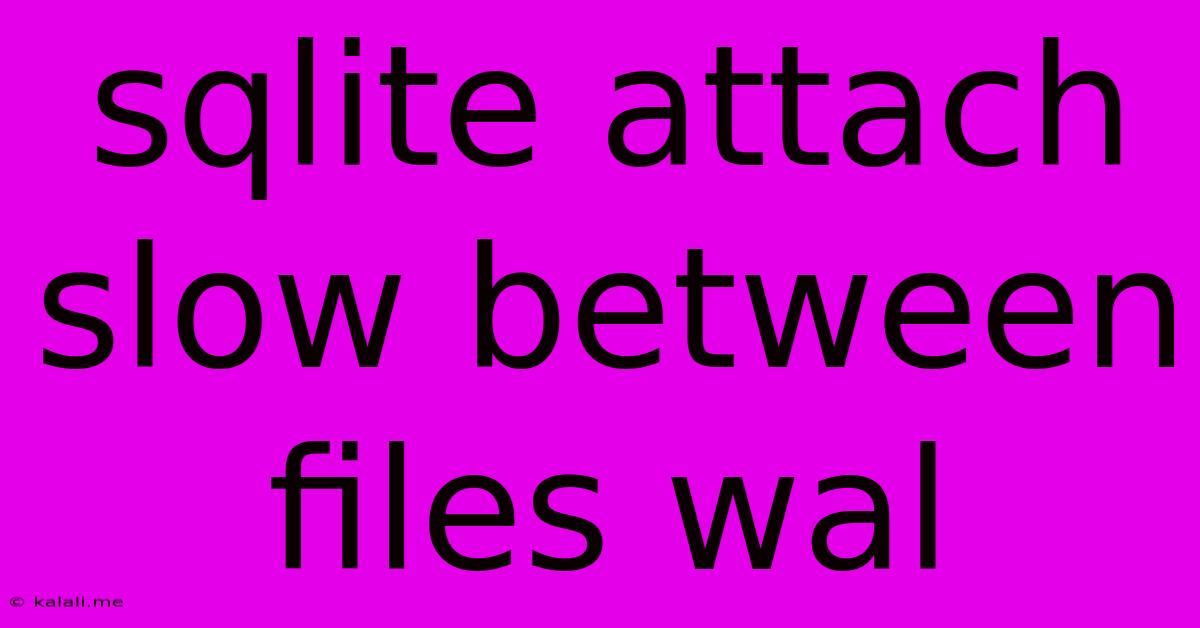Sqlite Attach Slow Between Files Wal
Kalali
Jun 09, 2025 · 3 min read

Table of Contents
SQLite Attach Slow Between Files with WAL: Troubleshooting and Optimization
Meta Description: Experiencing slow performance when attaching SQLite databases using the Write-Ahead Logging (WAL) mode? This article dives into common causes and provides effective solutions to optimize your SQLite database operations. Learn how to troubleshoot and improve the speed of your database attachments.
Attaching SQLite databases, particularly those utilizing the Write-Ahead Logging (WAL) mode, can sometimes lead to unexpectedly slow performance. This can significantly impact application responsiveness, especially when dealing with large databases or frequent attachments. This article explores the common culprits behind sluggish attachment times and offers practical strategies for optimization.
Understanding the WAL Mode and Attachment Process
Before diving into solutions, it's crucial to understand how SQLite's WAL mode works and how it interacts with the database attachment process. WAL improves concurrency and reduces the need for exclusive database locks compared to the older rollback journal mode. However, this enhanced concurrency can sometimes introduce complexities when attaching databases. The attachment process involves several steps, including reading the database schema and potentially loading parts of the database into memory. These steps can be amplified in WAL mode due to the additional metadata management and transaction logging involved.
Common Causes of Slow SQLite Attach with WAL
Several factors can contribute to slow attachment times when using WAL:
- Database Size: Larger databases naturally take longer to attach, as more data needs to be processed and loaded. This effect is amplified with WAL due to the overhead of processing the WAL files.
- Disk I/O Performance: Slow disk I/O is a major bottleneck. If your database files reside on a slow storage medium (e.g., a network drive or an overloaded hard drive), the attachment process will inevitably be slower. Solid State Drives (SSDs) offer significantly improved performance compared to traditional hard disk drives (HDDs).
- WAL File Size: Large WAL files can significantly increase the time it takes to attach a database. Regularly backing up and potentially pruning your WAL files can help mitigate this issue.
- System Resources: Insufficient system memory or CPU resources can lead to performance degradation during the attachment process. This is particularly true when dealing with large and complex databases.
- Database Corruption: A corrupted database file can cause significant delays during the attachment process, potentially leading to failures. Consider using SQLite's built-in integrity check tools to verify the database's consistency.
- Network Latency (for Network Drives): When attaching databases stored on network drives, network latency can significantly impact attachment times. Ensure a fast and stable network connection.
Strategies for Optimization
Here are several strategies you can employ to improve the speed of attaching SQLite databases in WAL mode:
- Upgrade Storage: Migrate your databases to a faster storage medium, such as an SSD. This often provides the most significant performance improvement.
- Optimize WAL Management: Regularly back up your database and consider using
PRAGMA wal_checkpointto reduce the size of the WAL file. A smaller WAL file will speed up the attachment process. - Improve System Resources: Ensure your system has sufficient RAM and CPU power to handle the database operations. Consider upgrading your system hardware or optimizing other resource-intensive processes.
- Database Optimization: Analyze your database schema and data for inefficiencies. Removing redundant data or optimizing table structures can improve overall performance, including attachment speed.
- Connection Pooling: If you're performing multiple attachments, consider using connection pooling to reduce the overhead of establishing new connections repeatedly.
- Asynchronous Operations: If possible, perform the attachment process asynchronously to avoid blocking the main application thread.
Monitoring and Troubleshooting
Utilize SQLite's built-in profiling and monitoring tools to identify specific bottlenecks. You can measure the time taken for different phases of the attachment process to pinpoint areas for improvement. Consider logging relevant information such as attachment times, database size, and system resource usage.
By carefully analyzing the causes of slow performance and implementing the suggested optimizations, you can significantly improve the speed and efficiency of attaching SQLite databases even when using the WAL mode. Remember that a combination of these strategies often yields the best results.
Latest Posts
Latest Posts
-
Sql Check If Temp Table Exists
Jun 09, 2025
-
How Long Does Parmesan Cheese Last After The Expiration Date
Jun 09, 2025
-
How Long Can Chicken Stay In Refrigerator After Defrosting
Jun 09, 2025
-
Whirlpool Super Capacity Stove Burner Gets Too Hot
Jun 09, 2025
-
Who Can Create A Private Police Force
Jun 09, 2025
Related Post
Thank you for visiting our website which covers about Sqlite Attach Slow Between Files Wal . We hope the information provided has been useful to you. Feel free to contact us if you have any questions or need further assistance. See you next time and don't miss to bookmark.